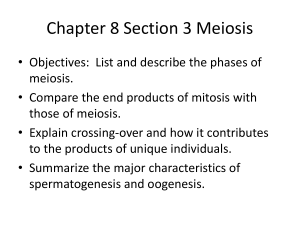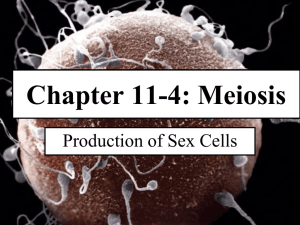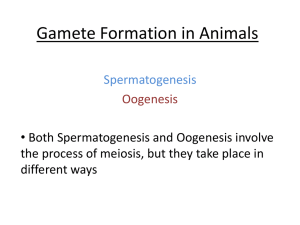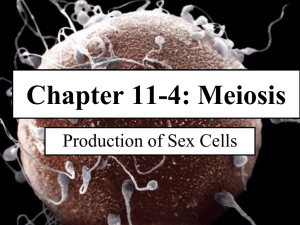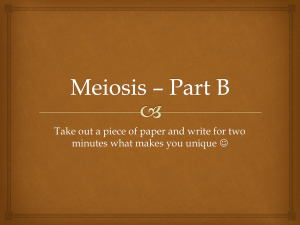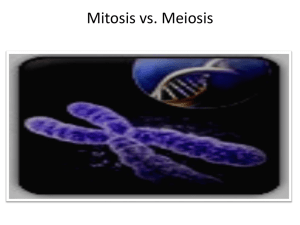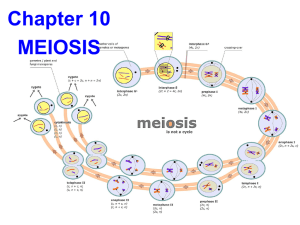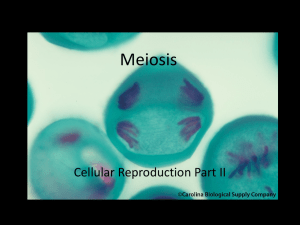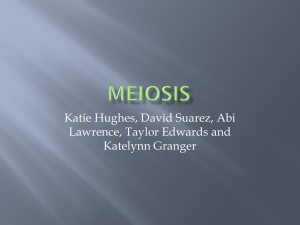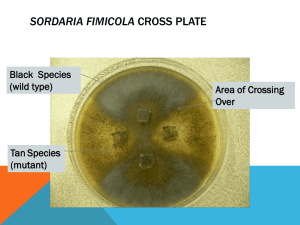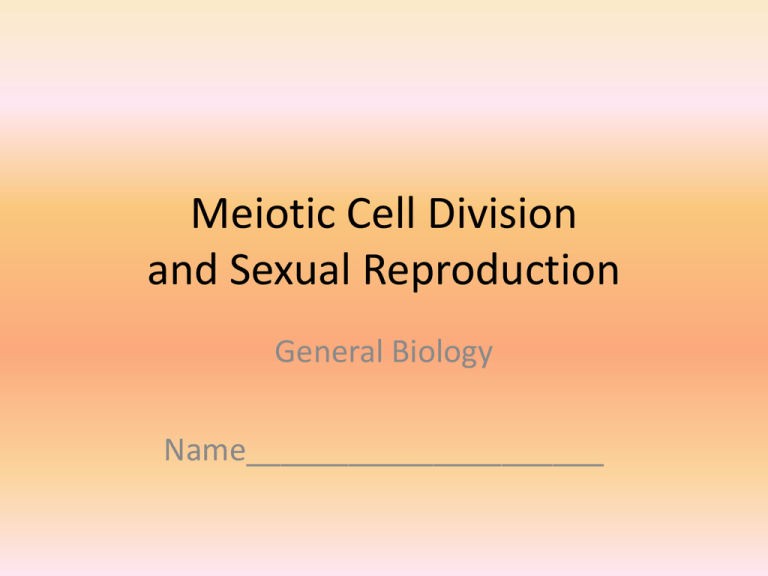
Meiotic Cell Division
and Sexual Reproduction
General Biology
Name_____________________
What is Meiosis?
• Meiosis is a type of cell division in which
sexually reproducing organisms produce sex
cells that contain HALF of the normal number
of chromosomes for that organism.
• At the time of fertilization, each genetically
unique egg and sperm will provide half of the
genetic instructions to form a unique offspring.
• Meiosis guarantees genetic variation in
offspring created by sexual reproduction.
Asexual vs. Sexual Reproduction
3
Where does meiosis take place?
• Start with a cell that has the full number of
chromosomes typical for this species – this is
known as a DIPLOID cell.
• A diploid cell is one that contains one or more
PAIRS of chromosomes, carrying paired genes
that determine the traits o the organism.
• Meiosis occurs only in certain cells of the
organism, such as the ovaries or testes in a
human.
Paired chromosomes
• DNA replication occurs in preparation for meiosis, so
the chromosomes are double armed, each DAC
consisting of two identical sister chromatids.
• A matching pair of chromosomes is called a
HOMOLOGOUS PAIR. The pair has a maternal
homolog and a paternal homolog that were
inherited from that organism’s mother and father.
• Cells with paired chromosomes are DIPLOID (2n).
• Cells without paired chromosomes are HAPLOID (n).
Homologous Pairs
Genetic
instructions for
Blood type A
from mother
• Same size
• Same shape
• Same pattern of bands
when stained
• Have matching genes in
the same locations
• BUT the specific form of
each gene (called an
ALLELE) may differ
Genetic
instructions for
Blood type B
from father
Karyotyping
Scientists can
prepare a
karyotype from a
body cell of an adult
or baby to look for
chromosomal
abnormalities
(damaged, missing
or extra
chromosomes).
7
Meiosis Involves Two Cell Divisions
MEIOSIS 1
MEIOSIS 2
• During the second cell
• During he first cell division
division (IPMATC-2) we start
(IPMATC-1) we start with a
with a haploid cell that
diploid cell that contains
contains double armed
double armed chromosomes.
chromosomes.
• The double armed
• The DAC line up single file
chromosomes line up in pairs
along the equator, then the
along the equator and they
sister chromatids are pulled
may swap some genes. Then
apart.
the pairs are pulled apart.
• Each cell divides into two
haploid cells containing
• The cell divides into two
single armed chromosomes.
haploid cells containing DAC.
Meiosis
Meiosis in Males (Spermatogenesis)
• One full cycle of meiosis
produces FOUR haploid
cells of equal size.
• In humans these cells
will develop into
functional sperm cells
as they mature in the
testes.
Meiosis in Females
• One full cycle of meiosis produces FOUR haploid cells but
they are NOT equal in size.
• Since the cytoplasm divides unequally, the result is one
large egg cell and three small nonfunctioning cells called
polar bodies.
In humans
the egg will
mature in the
ovary.
Meiosis as a Source of Variation
• SORTING OF GENES (“Independent Assortment”)
– The two members of each homologous pair may carry
different alleles, so the way the different pairs randomly line
up in relation to other pairs leads to many possible
combinations in the sex cells that result.
Meiosis as a Source of Variation
• CROSSING OVER
– As homologous
chromosomes pair up
during Meiosis 1, they
can “swap” or exchange
genes.
– After separation each set
is unique so there are no
two sperm or egg cells,
even from the same
parent, that are alike
Meiosis as a Source of Variation
• RECOMBINATION - Each sperm and egg
contain a unique combination of genetic
instructions due to meiosis
• At fertilization the full species number of
chromosomes is restored.
• This unique combination of thousands of
genes at fertilization produces an offspring
that is genetically similar (but not identical) to
the parents.
When Meiosis Goes Wrong
• Trisomy = having three copies
• Nondisjunction
(instead of two) of a
is the failure of
chromosome
chromosomes to
– Ex. Down Syndrome (Trisomy 21)
separate properly
during Meiosis 1 or 2. • Monosomy = having one copy
(instead of two) of a
• The resulting sex cells
chromosome
may have an extra or
– Ex. Turners Syndrome (Females
missing chromosome.
inherit only one sex
• Most of the time, the
chromosome)
consequences are so
severe that a resulting • Deletion = when part of a
chromosome is missing
zygote cannot
– Ex. Cri-du-Chat (deletion of part
survive.
of Chromosome #5)
At Fertilization, two haploid gametes
join to form a diploid ZYGOTE
In Humans…
17
MITOSIS
MEIOSIS
Body cells (somatic)
Sex cells (gametes)
1 2
1 4
Diploid (2n=46)
Diploid (2n=46)
Diploid (2n=46)
Haploid (n=23)
1
1
1
2
Kinds of cells produced
Number of cells produced
Chromosome number of parent cell
Chromosome number of daughter cells
Number of times the DNA is replicated
Number of cell divisions
Function
1) To form new cells during
growth or to repair damaged
To form gametes for
cells.
sexual reproduction.
2) To produce a new organism
during asexual reproduction.


